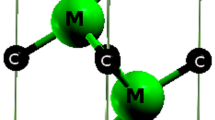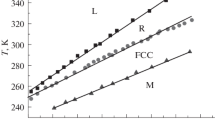Abstract
Density functional theory (DFT) calculations including spin polarization were performed to obtain the energies for all end-member configurations of the μ phase, which were used to evaluate the Gibbs energies of the μ phase. The Co–W system was thermodynamically re-assessed in the present work. The present calculated phase diagram fits well with the experimental data. Applying the DFT results was essential for giving a better description of the μ phase.







Similar content being viewed by others
References
Sato J, Omori T, Oikawa K, Ohnuma I, Kainuma R, Ishida K (2006) Cobalt-base high-temperature alloys. Science 312:90–91
Suzuki A, Inui H, Pollock TM (2015) L12-strengthened cobalt-base superalloys. Annu Rev Mater Res 45:345–368
Ishida K (2008) Intermetallic compounds in Co-base alloys–phase stability and application to superalloys. In: MRS proc Cambridge Univ Press, pp 1128-U1106-1106
Olson GB (2014) Preface to the viewpoint set on: the Materials Genome. Scr Mater 70:1–2
Wang P, Xiong W, Kattner UR, Campbell CE, Lass EA, Kontsevoi OY, Olson GB (2017) Thermodynamic re-assessment of the Al–Co–W system. CALPHAD 59:112–130
Naidu SVN, Sriramamurthy AM, Rao PR (1986) The Co–W (cobalt–tungsten) system. Alloy Phase Diagr 2:43–52
Kreitz K (1922) Co–W alloys. Metall Erz 19:137–140
Takeda S (1936) A metallographic study of the action of the cementing materials for cemented tungsten carbide. Science Rept Tohoku Univ, Honda Anniv, pp 864–881
Haschimoto U (1937) Relation between the allotropic transformation of cobalt and some additional elements. J Jpn Inst Met 1:177–190
Åkesson L (1982) An experimental and thermodynamic study of the Co–W–C system in the temperature range 1473–1698 K. Uppsala University, Sweden
Gabriel A, Allibert C, Ansara I, Lukas H (1985) Experimental and calculated phase diagrams of the Ni–W, Co–W and Co–Ni–W system. Z Metallkd 76:589–595
Sykes W (1933) The cobalt–tungsten system. Trans ASST 21:385–421
Larikov LN, Shimatko OA (1967) Dokl Akad Nauk USSR 29:540–542
Takayama T, Wey MY, Nishizawa T (1981) Effect of magnetic transition on the solubility of alloying elements in bcc iron and fcc cobalt. Trans J Inst Met 22:315–325
Sato J, Oikawa K, Kainuma R, Ishida K (2005) Experimental verification of magnetically induced phase separation in αCo phase and thermodynamic calculations of phase equilibria in the Co–W system. Mater Trans 46:1199–1207
Dmitrieva G, Cherepova T, Shurin A (2005) Phase equilibria in Co-CoAl-W alloys. Met Sci Treat Met 4:3–6
Ravi R, Paul A (2011) Interdiffusion study on Co (W) solid solution and topological close-packed μ phase in Co–W system. Intermetallics 19:426–428
Neumeier L, Holman JL (1967) The tungsten-cobalt for compositions to 85 atomic percent cobalt. U.S. Department of the Interior, Bureau of Mines, Washington
Koster W, Tonn W (1932) The binary systems cobalt–tungsten and cobalt–molybdenum. Z Metallkd 24:296–299
Efimova TV, Polotnyuk VV, Shmtko OA (1970) Decomposition of supersaturated solid solutions of tungsten in cobalt studied by thermo-magnetic method, Fazovye. Prevrashch 32:56–59
Dmitrieva G, Vasilenko V, Melnik I (2008) Al–Co–W fusion diagram in the Co–CoAl–W part. Chem Met Alloys 1:338–342
Scientific Group Thermodata Europe: SGTE. https://www.sgte.net/en/free-pure-substance-database. visited 21 June 2018
Redlich O, Kister AT (1948) Algebraic representation of thermodynamic properties and the classification of solutions. Ind Eng Chem 40:345–348
Hillert M (2001) The compound energy formalism. J Alloy Compd 320:161–176
Kusoffsky A, Dupin N, Sundman B (2001) On the compound energy formalism applied to fcc ordering. CALPHAD 25:549–565
Ansara I, Burton B, Chen Q, Hillert M, Fernandez-Guillermet A, Fries SG, Lukas HL, Seifert H-J, Oates WA (2000) Models for composition dependence. CALPHAD 24:19–40
Wang P, Peters MC, Kattner UR, Choudhary K, Olson GB (2019) Thermodynamic analysis of the topologically close packed σ phase in the Co-Cr system. Intermetallics 105:13–20
Wimmer E, Krakauer H, Weinert M, Freeman AJ (1981) Full-potential self-consistent linearized-augmented-plane-wave method for calculating the electronic structure of molecules and surfaces: O2 molecule. Phys Rev B 24:864–875
Kohn W, Sham LJ (1965) Self-consistent equations including exchange and correlation effects. Phys Rev 140:A1133–A1138
Perdew JP, Burke K, Ernzerhof M (1996) Generalized gradient approximation made simple. Phys Rev Lett 77:3865
Blöchl PE, Jepsen O, Andersen OK (1994) Improved tetrahedron method for Brillouin-zone integrations. Phys Rev B 49:16223
Liechtenstein AI, Katsnelson M, Antropov V, Gubanov V (1987) Local spin density functional approach to the theory of exchange interactions in ferromagnetic metals and alloys. J Magn Magn Mater 67:65–74
Hillert M, Jarl M (1978) A model for alloying in ferromagnetic metals. CALPHAD 2:227–238
Joubert J-M, Dupin N (2004) Mixed site occupancies in the μ phase. Intermetallics 12:1373–1380
OQMD: The open quantum materials database. http://oqmd.org/. Visited 21 June 2018
Saal JE, Kirklin S, Aykol M, Meredig B, Wolverton C (2013) Materials design and discovery with high-throughput density functional theory: the open quantum materials database (OQMD). JOM 65:1501–1509
Kirklin S, Saal JE, Meredig B, Thompson A, Doak JW, Aykol M, Rühl S, Wolverton C (2015) The open quantum materials database (OQMD): assessing the accuracy of DFT formation energies. NPJ Comput Mater 1:15010
Acknowledgements
This work was performed under the following financial assistance award 70NANB14H012 from US Department of Commerce, National Institute of Standards and Technology as part of the Center for Hierarchical Materials Design (CHiMaD).
Author information
Authors and Affiliations
Corresponding author
Additional information
Publisher's Note
Springer Nature remains neutral with regard to jurisdictional claims in published maps and institutional affiliations.
Electronic supplementary material
Below is the link to the electronic supplementary material.
Rights and permissions
About this article
Cite this article
Wang, P., Kontsevoi, O.Y. & Olson, G.B. Thermodynamic analysis of the Co–W system. J Mater Sci 54, 10261–10269 (2019). https://doi.org/10.1007/s10853-019-03616-3
Received:
Accepted:
Published:
Issue Date:
DOI: https://doi.org/10.1007/s10853-019-03616-3




